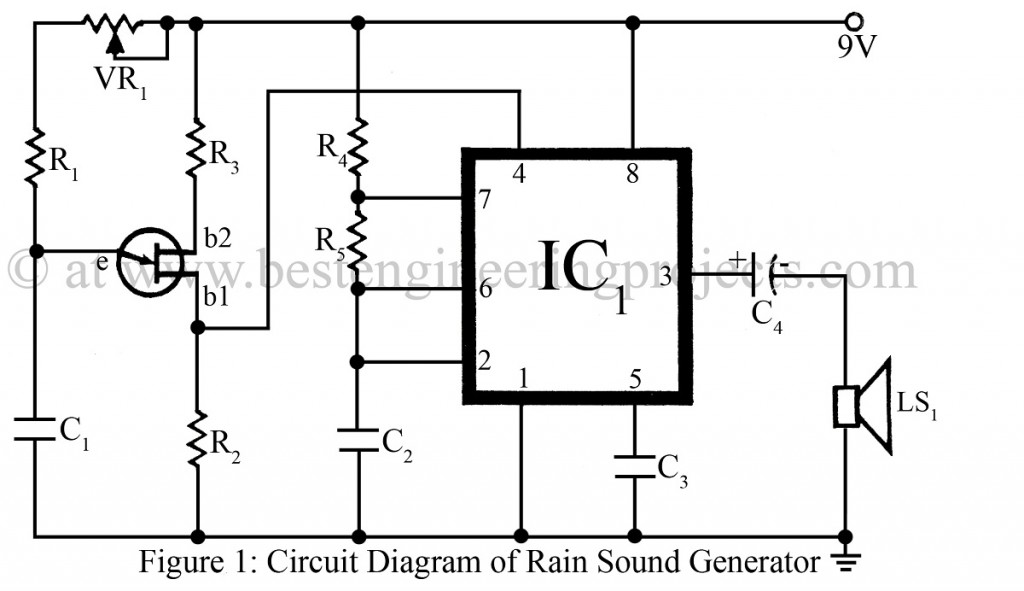The project described here is of “Rain Sound Generator Circuit” which is simple and uses ordinary components. It comprises two oscillators: one is a variable low-frequency oscillator that uses UJT 2N2646 (T1) and the other one uses timer IC NE555. A single UJT (Unijunction Transistor) can be oscillated without using a tank coil. The electrical characteristics of UJT are quite different from ordinary bipolar transistors.
The second oscillator using timer IC NE555, IC1 is in astable mode. Here, T1 acts as the noise generator for the circuit. The sound produced from the circuit containing the UJT is given as input to the IC1 via its pin 4. But if UJT does not conduct, pin 4 of IC1 becomes inactive. So the operation of 555 depends on the conduction of UJT. The amplification is carried out and its output is fed as input to the capacitor. The capacitor then gives out the sound produced and is heard by the human ears from a device that converts the electrical energy i.e. the electrical signal to sound energy. In this way, a new type of sound, i.e. the sound of rain, is generated from the speaker.
A simple 9V DC unregulated power supply can be used. The project Rain Sound Generator was successfully tested with a power supply unit using 0 – 9V, 500mA step-down transformer, four rectifier diodes i.e. 1N4001, and a 1000 µF, 16V capacitor.
The Rain Sound Generator circuit has been said to be first discovered and implied by Japanese researchers. With so much time spent in front of screens, people have tended to develop various disorders associated with eyes and sleep. The blue rays coming from the screens tend to inculcate sleeplessness in us. And as an alternative to pills for insomnia, the rain sound generator has been one of the useful applications to aid people with insomnia with its relaxing effect. The sound of the rain is known to relax our brain, calm us, and in some cases, act as a tonic for anxiety as well.
Check out other interesting alarm circuits posted on bestengineeringprojects.com
PARTS LIST OF RAIN SOUND GENERATOR CIRCUIT
|
Resistors (all ¼-watt, ± 5% Carbon) |
|
R1, R5 = 47 KΩ R2 = 100 Ω R3 = 47 Ω R4 = 1 KΩ VR1 = 100 KΩ |
|
Capacitors |
|
C1, C2 = 0.04 µF (Ceramic Disc) C3 = 0.01 µF (Ceramic Disc) C4 = 100 µF, 12V (Electrolytic Capacitor) |
|
Semiconductors |
|
IC1 = NE555 (Timer IC) T1 = 2N2646 (silicon PN Unijunction Transistors) |
|
Miscellaneous |
|
LS1 = 8Ω, 0.5W 5 cm speaker |

Greetings , I have made the circuit as shown here but I’m not hearing anything when I turn it on , pins 4 and 7 are connected together ?
It’s not that clear on the diagram you give
Please answer as soon as possible
Thanks
No, these two pin are not connected together, pin 4 is connected to b1 of transistor T1.
Hi, if i using AC 9V for this circuit is it ok?
you must have to use DC source.
sir can i use 741 ic on this ckt?
Sorry, you cannot use IC 741 in the circuit. IF you use IC741 as oscillator then entire circuit will changed.
In which tool we can do simulation of this circuit
Do we get rain sound in output ?
Pls reply Asap
Thanks
You can simulate a circuit in proteus but for sound, you have to assemble the circuit as shown in the circuit diagram.
I’m getting error between IC point 3 and C4 in simulation what’s the reason
Could please share the simulation file if possible
Please reply Asap
Thank you
I’m getting error between ic point 3 and c4
Cloud U pls share simulation video
Pls reply asap
Thanks
Hi,
Thanks for the circuit. Please could you tell me the function of the variable resistor VR1? Is it for volume control?
Hi Tec,
The variable resistor VR1 is used to adjust the oscillating frequency of UJT T1 (2N2646).